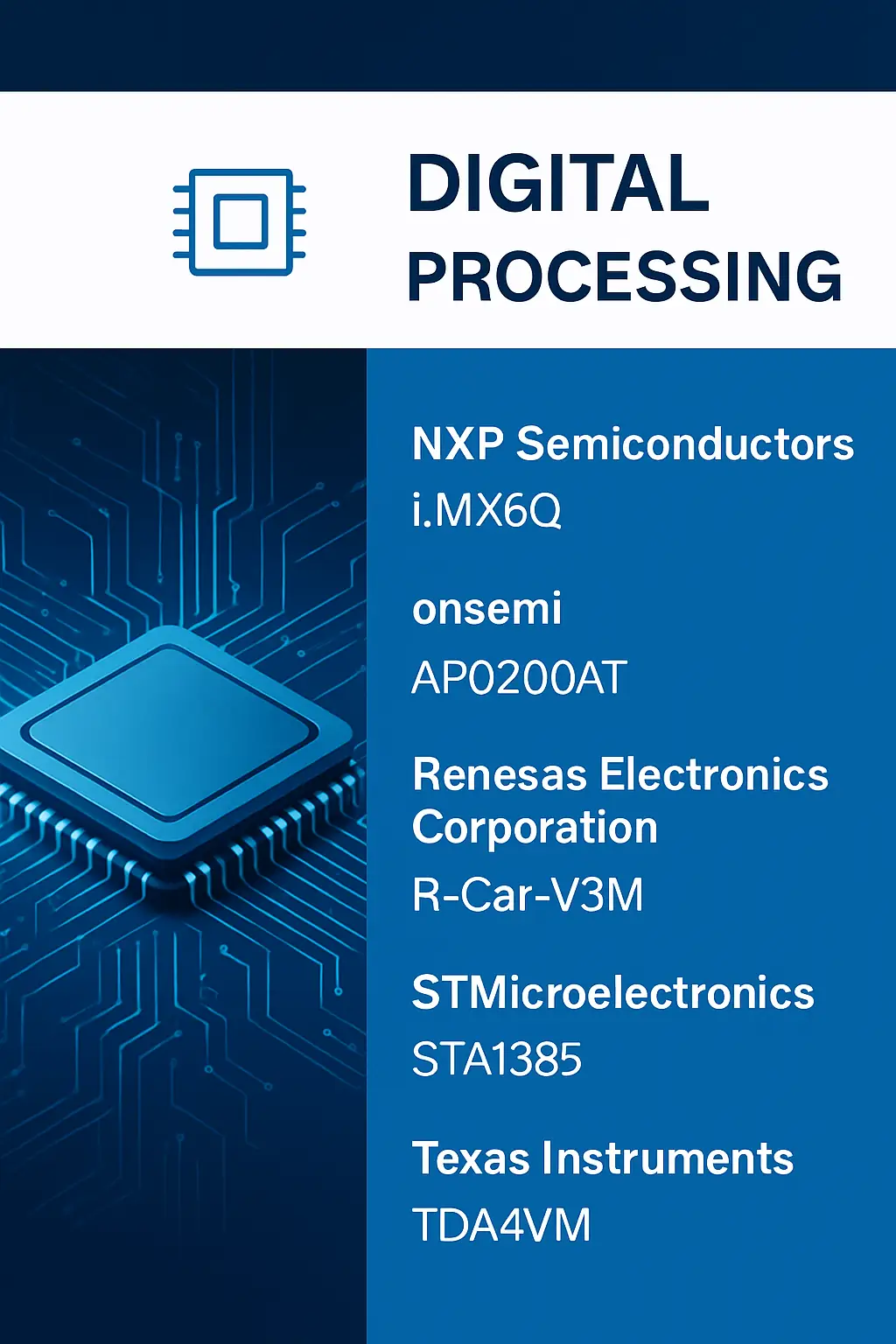Digital Processing
Automotive Electronics refers to the electronic systems and components used in modern vehicles to enhance performance, safety, and convenience. Among these, ADAS (Advanced Driver Assistance Systems) and Autonomous Driving technologies play a crucial role in improving road safety and driving experience. Within this domain, Automotive Camera Systems are essential for capturing real-time visual data, enabling features such as lane detection, object recognition, and parking assistance. These systems rely on Digital Processing to analyze the captured images, interpret the environment, and support decision-making processes. The integration of high-resolution cameras with advanced processing units allows vehicles to perceive their surroundings accurately, contributing to safer and more intelligent driving. Automotive camera systems are widely used in applications such as rearview cameras, 360-degree view systems, and forward-facing cameras for collision avoidance. Digital processing ensures that the data is analyzed quickly and efficiently, enabling real-time responses. These technologies are fundamental in the development of autonomous vehicles, where accurate perception and rapid processing are critical for safe navigation. As automotive electronics continue to evolve, the combination of camera systems and digital processing will drive innovation in vehicle safety, comfort, and automation. This technology is essential for both current driver assistance systems and future fully autonomous vehicles.
Details
Digital Processing

Related Parts
| Series Name | Description | Manufacturer Name | Attribute Description |
|---|---|---|---|
| NXP Semiconductors | Cortex-A7 core, up to 900 MHz, 128 KB L2 cache, integrated PMU, 32-bit ARM architecture, supports DDR3/LVDDR3/DDR3L, 2D/3D graphics acceleration, multiple connectivity interfaces including USB, Ethernet, UART, SPI, I2C. | ||
| NXP Semiconductors | Quad-core ARM Cortex-A9 up to 1.2 GHz, 32-bit DDR3/LVDDR3, integrated 2D/3D graphics, 1080p video encode/decode, multiple display interfaces, PCIe, USB, Ethernet, CAN, I2C, SPI, UART. | ||
| NXP Semiconductors | Dual-core ARM Cortex-A9 up to 1 GHz, 32 KB L1 cache, 256 KB L2 cache, integrated 2D/3D graphics, 1080p video encode/decode, dual-display support, 1.2V core, 3.3V I/O, 400-ball FBGA package. | ||
| NXP Semiconductors | Quad-core ARM Cortex-A9 up to 1.2 GHz, 32/64-bit DDR3/LPDDR2, integrated 3D/2D graphics, 1080p video encode/decode, multiple display interfaces, PCIe, USB, Ethernet, CAN, I2C, SPI, UART, security engine, 40nm process. | ||
| NXP Semiconductors | Quad-core ARM Cortex-A9, 1.2 GHz, 32 nm, OpenGL ES 2.0, 1080p video encode/decode, DDR3/LPDDR2, PCIe, USB 2.0, HDMI, CAN, I2C, SPI, UART, 1.8–3.3 V operation | ||
| NXP Semiconductors | Quad-core ARM Cortex-A9 up to 1.2 GHz, 3D/2D graphics, 1080p video encode/decode, dual display, PCIe, USB, Ethernet, CAN, I2C, SPI, UART, 1 GB DDR3/LPDDR2 support. | ||
| NXP Semiconductors | ARM Cortex-A9 core, up to 1.2GHz; 32KB I-cache, 32KB D-cache; integrated GPU, 1GB DDR3/LPDDR2 support; 2D/3D graphics acceleration; 1080p video encode/decode. | ||
| NXP Semiconductors | ARM Cortex-A9 core, up to 1 GHz, 32-bit DDR3/LPDDR2, 2D/3D graphics, 1080p video decode, low power consumption, integrated power management, multiple connectivity interfaces. | ||
| NXP Semiconductors | Cortex-A7 core, up to 1 GHz, single-core processor, 32 KB L1 cache, 128 KB L2 cache, 1.2V/1.8V operation, 40nm LP process, supports DDR3, DDR3L, LPDDR2 memory. | ||
| NXP Semiconductors | Cortex-A9 core, up to 1.2GHz; integrated GPU, 2D/3D graphics; 1GB LPDDR3 support; dual 10/100Mbps Ethernet; CAN, USB, UART, I2C, SPI interfaces; supports Linux, Android OS. |








.png?x-oss-process=image/format,webp/resize,h_32)










